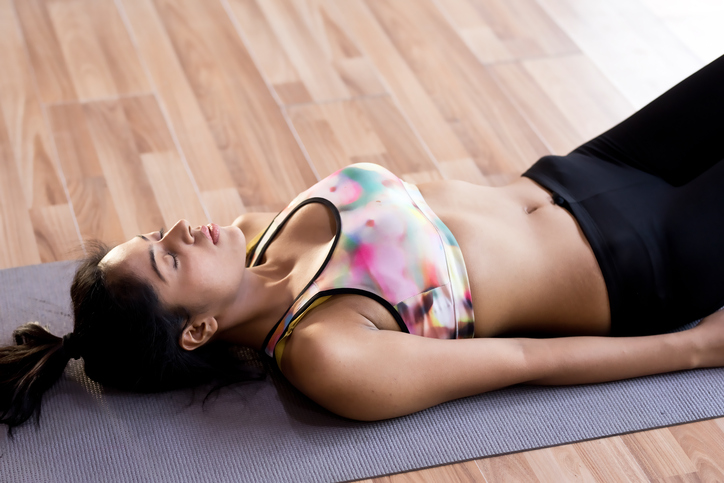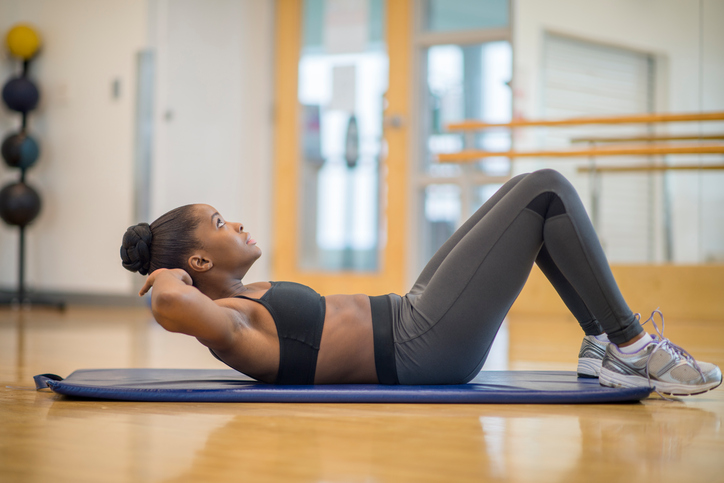There is a right and wrong was to do postnatal exercise, says Lulu Adams, celebrity trainer to Made In Chelsea’s Binky Felstead. She shares 19 tips new mums need to know
Getting back into a regular fitness routine post-bubba is often the last thing on a new mother’s mind. But Binky Felstead, who found fame on 13 series of Made In Chelsea (MIC) started back at her exercise sessions just eight weeks into motherhood.
Announcement of the 27 year old’s pregnancy left fans and co-stars alike stunned, especially as her and the father, JP (fellow MIC star Joshua Patterson) had just ended a fiery relationship.
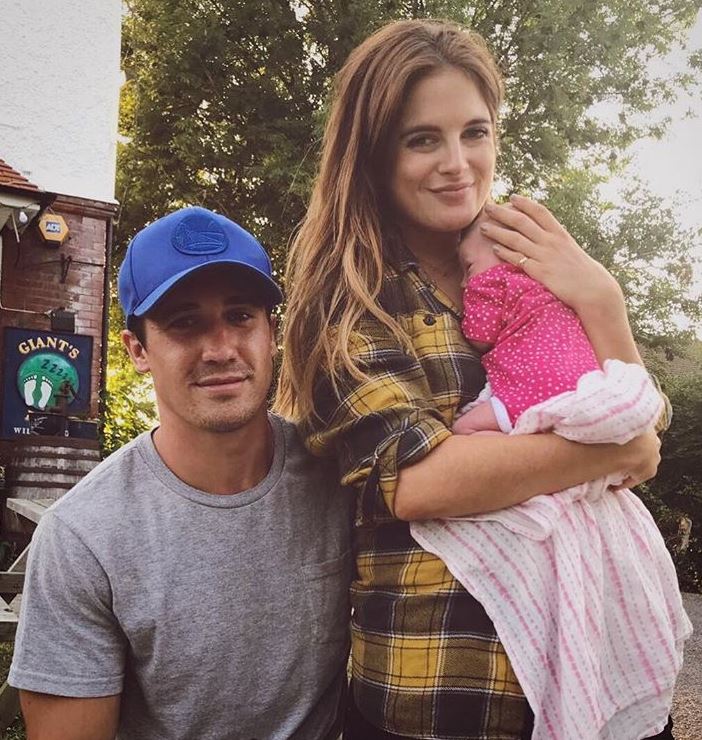
Celebrities’ fast track to baby weight loss can leave new mothers feeling down about themselves, but Binky claimed there’s a healthy way to go about it.
‘Been given the all clear to train again and taking it slow and steady’, she said in a video workout post on Instagram. ‘Just because I’ve made the decision to start working out, shouldn’t make other mothers feel bad or pressured to if they haven’t!
Each to their own, do what makes YOU feel good’, she wrote.
https://www.instagram.com/p/BbKk7Y2Bo-A/?hl=en&taken-by=binkyfelstead
TRY: Healthista’s favourite supplements for pregnancy
The MIC favourite had made a a name of herself as a fitness fanatic over the previous year. She has admitted to having low self-esteem when it comes to her body image, emphasised by the pressures of her on-screen career. The first few series of MIC gave a glimpse into the then 19-year-old’s party life with co-star Louise Thompson, a time she spent primarily on ‘toast, curry and red wine’, according to an interview with Women’s Health. But the two ditched boozy nights for hardcore gym sessions, transforming their lifestyles and figures. ‘Alcohol makes me chubby’, she told The Sun. Not only that, but Binky’s new approach to health and fitness she says helped her overcome her anxiety, too.
Don’t try this yourself until you’re sure your body can cope
When it comes to post-baby, Binky first turned to good friend of 10 years and pre- and post- natal personal trainer, Lulu Adams. But Lulu’s first advice was to see a women’s health physiotherapist. ‘I went to six physio sessions eight weeks after India’s arrival to have my abs and pelvic floor checked to see how I was REALLY recovering’, said Binky. ‘It’s a part of the body we don’t really see/think about before pregnancy but it is SO important… I have been cleared to do slightly higher impact work than might be suggested for someone 4 months in… so basically don’t try this yourself until you’re sure your body can cope’, she told her 1.4 million Instagram followers.
Now, Lulu, who is currently pregnant with her second child, tells Healthista the most important things to consider after giving birth to stay healthy.
Binky Felstead’s postnatal workout
‘I first send my clients an in depth questionnaire because some of the things I ask tend to be intimate. I’ll ask a lot about pelvic floor and graphic questions like ‘are you leaking?’ which women are quite embarrassed to talk about face to face. I will then do an in depth analysis of how they move and what their posture is like. There is a lot to consider, which is why I think people can really benefit from a personalised plan rather than just guessing what’s good for their body or jumping back into classes. I would say she was really lucky because she had an easy recovery process compared to many.
I would say Binky was really lucky because she had an easy recovery process compared to many
‘Binky loves her big sweaty workouts but she wanted to make sure she was doing the right thing first and being safe. She was never in a rush to get skinny, she just wanted to get moving again and doing what she enjoys and she always feels better after going to the gym like most of us do. We took it right back to basics and started rehab that she could do alongside her workouts. I focus predominately on core rehab but we’ve done workouts that high intensity training but low impact which is safe for someone recovering. We’ve slowly introduced more resistance but that doesn’t need to be dumbbells. Resistance bands are great for new mums.’
TRY: Pilates for pregnancy workout
Here’s an example of Binky’s workout below:
https://www.instagram.com/p/Ba1FFdHjcSb/?taken-by=luluadamsfitness
1. Your body has been through a lot of change
As we grow through pregnancy, the natural S shape of the spine tends to become slightly distorted where the uterus pulls the lower back down into a big arch. As boobs grow the upper body compensates as well. These things cause quite a lot of pain and discomfort in day to day life during pregnancy and going forward.
2. The abs need special care
As your baby grows it pushes everything else out of the way such as the bowel and diaphragm. Most diastasis recti – the gap that occurs during pregnancy between the abdominal muscles – can heal itself within 8-10 weeks. But a lot of people need helping hands and rehabilitation exercises to get it going. When I see a client I’ll have a look at their abdominal wall by doing a palpation test. I’ll have them lie on the floor and lift their head into a mini crunch and I push down on the connective tissue that runs between the two muscles of the abdomen. That gives me a good picture of how they are healing and what sort of exercises we need to look at.
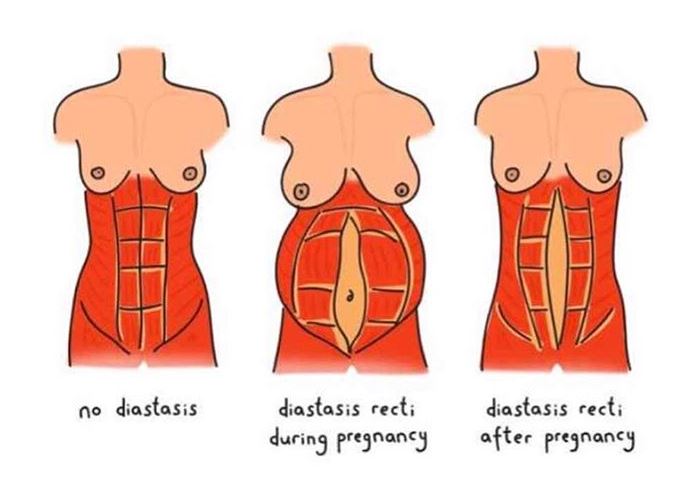
3. How to retrain the core
‘Whatever the case, you need to retrain the core. Within the core you’ve got the rectus abdominis, which are the muscles you see in a six pack. Underneath you’ve got what I call the deep core unit which is the diaphragm, an internal muscle which sits under the ribcage and assists breathing. You have the multifidus which are small muscles which run down your spine to stabilise it. The TBA (transversis abdominis) is the deep layer of muscle which runs round the body like an internal corset. And then you have the pelvic floor. This core is central to our strength and so it’s important to pay attention to it.’
If you don’t exercises, chances are you’re going to end up with more discomfort in your day to day life
‘The exercises tend to be a little bit boring and don’t look like much or cool on an Instagram post. But they are really going to do you favours in the long term. You’re training small tiny muscles to work well, before you work the big muscles. It’s important to see the early months as a rehab stage, which is invaluable. By spending a little time doing rehab you can avoid aches and pains that we often dismiss as part of motherhood – an achey back for example. If you learn how to work your core muscles you’re going to prevent over-utilising those lower back muscles and causing yourself pain. Motherhood early on is so demanding – picking up the kids’ toys off the floor, pushing buggies and lack of sleep can generally contribute to you being in pain – alot. If you don’t exercise, chances are you’re going to end up with more discomfort in your day to day life and you won’t be strong.’
https://www.instagram.com/p/BaQuZmtBCeD/?hl=en&taken-by=binkyfelstead
4. The pelvic floor is a big deal
‘Pelvic floor is part of what we call your deep core. I teach clients to engage the pelvic floor along with those other muscles on an exhale breath, and then relax them all on the inhale (see exercises at the end of this post).
‘Can leaking be reversed? My mantra is ‘never give up on soft tissue’, so my initial answer to this would be a yes. But obviously everyone is different. I would say that if you are suffering from leaking, seeing a women’s health physiotherapist should be your first port of call and they will give you a realistic outlook on ‘fixing’ the problem.’
READ: 8 pelvic floor exercises you need for better sex
5. If you don’t do anything else, see a women’s health physiotherapist
‘My first bit of advice for Binky and everyone is to go and see a physiotherapist specialising in women’s health. They perform an internal examination for your pelvic floor – I can only look at the core and feel the tummy. It’s the most reassuring thing you can do as mother going back into exercise. With Binky, they were really happy and said everything was healing well on its own. For me, during the pushing phase of my last labour, I suffered an umbilical hernia which is where a little hole appears in the connective tissue in the midline. It took me ages to get it diagnosed – so many GPs just dismissed me but a women’s health physio spotted it.’
6. Stick to low impact
The pelvic floor has been through a significant trauma
I keep all my clients in six months post-partum in the low impact zone because even if the pelvic floor is healing well, it’s still worth protecting it. It’s been through a significant trauma. With Binky we do cardiovascular, full body strength and high intensity training at low intensity. She can still lift weights, squat and work the glutes. But I always make sure that the core is engaged.
7. Pregnancy workouts are a must
‘Someone who had good posture before their pregnancy and was quite strong may be able to maintain a fairly neutral posture more than someone who was already suffering from a bit of a curved spine or hunched shoulders.
‘You don’t need to be signed up to a gym or with a personal trainer four times a week, it’s just worth knowing the benefits of good cardiovascular health. You could do a swimming lesson or Pilates class once a week. If you’re walking 4-5 times a week you’re actually going to stand yourself in better stead to avoid things like varicose veins, piles or swelling of the ankles and feet. Lifting weights can help maintain good posture.
‘There are core exercises you should avoid as the core starts to seperate. These are sit ups, planks, V-sits and push ups which all put a huge amount of pressure on the core. Admittedly some women who are really well-conditioned are able to continue with these well into their third trimester, but for most of us these will be too much. There are three types of exercises you can build into your programme. There is anti rotation, anti extension and anti lateral flexion. These are exercises that work the deep muscles and on stabilisation rather than anything else, and that’s super important during pregnancy. You can do this at home, as the movements tend to be very small and uncomplicated. It’s best to seek out help of a well-qualified PT to show you how to do these properly, but some examples are pallof press and dumbbell suitcase (or overhead rack) carry.’
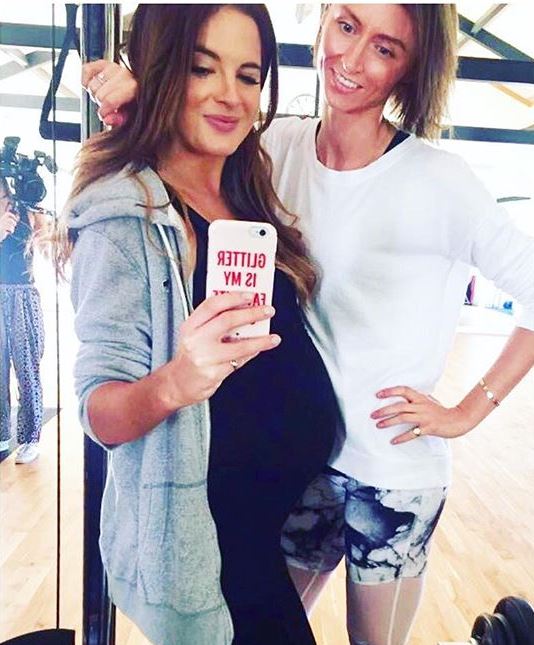
8. You need to know about pelvic organ prolapse
‘I never heard about it when my friends or I had babies. But prolapse (pelvic organ prolapse) to some extent is as common as one in three women after childbirth, so we need to be aware of it. It’s when your reproductive organs collapse down. Women’s Health Physio Niamh Burn explains it well:
“Pregnancy and childbirth can stretch the pelvic floor, ligaments and fascia within the pelvis that help keep these organs in place. An episiotomy, vaginal tear or use of forceps can add to the damage that may weaken the pelvic floor that supports these organs. Interestingly the incidence of POP increases when moving from child 2 to 3. POP can still occur after a C-Section, this is thought to be due to the stretch on the pelvic floor that happens during pregnancy. Symptoms include a heaviness or bulge or dragging sensation in the vagina that wasn’t there before, painful sex, obstructed intercourse from something in the way, vaginal laxity or wind, leaking urine, incomplete emptying, increased urgency to use the loo or difficulty passing a bowel motion.”
I have clients in tears who say, ‘why did no one warn me about this?’
‘Some women, if they aren’t leaking after childbirth or have any warning signs, think everything is fine and go back to lifting heavy weights or exercise. Holding their breath in the wrong way during exercise can cause problems although it might not happen straight away. But when they go to have their second or third child, they will see problems like POP, which can be life changing and debilitating. I have clients in tears who say, ‘why did no one warn me about this?’ I would recommend taking things slowly rather than trying to jump back into the skinny jeans.’
9. Keep hydration up
‘I would encourage women to keep an eye on their water intake as it’s crucial to cell recovery. Two litres a day and more if you exercise or are in a hot climate. It’s so important if you are breastfeeding too.’
10. Ditch sugar
‘I advise ditching refined sugar and even keeping natural sugars to an absolute minimal. This is because sugar is inflammatory and when cells are trying to heal sugar doesn’t help that process. In fact, it worsens things.’
11. Go organic
‘You need to have a lot of good quality protein because they are the building blocks of our body and will help the body to heal. It means free range chicken, organic if possible. Find a good butcher and get grass fed beef which is a great way of making sure your food is going to be nutritious. Cheap beef is not going to do you any favours as its just full of water and crap basically.’
12. Fats are friends
‘You need a lot of healthy fats too, which are luckily trendy now as we come around to the idea that they are good for us. In the 1980s people were scared of fat but that’s not the case anymore. Good fats such as avocado, nut butters, cold olive oil and cooking with coconut oil are so good for our skin health and nails.’
SHOP: Healthista’s favourite health oils here
13. Dose up on collagen
‘If you’ve got good quality collagen, which is a stretchy like fibre we all produce throughout our bodies that’s vital to cell recovery, the diastasis recti will heal a lot quicker. Some people will have this due to good genes. My big go-to for people is bone broth which is fairly easy to do. The next time you have a Sunday roast, keep the carcus and pop it in the oven with a splash of apple cider vinegar. After they have roasted off, boil them. This pulls out all the collagen from the bones. Put it in the fridge overnight and then spoon off the fat as much as you can to get a clear broth, reduce down again if you need to. You can then freeze it and have it daily. I also tell my pregnant clients to do this in their last tri-mester, building up a stock pile of it. If you can have a pint of this a day when your post-natal its definitely going to speed up the healing process.
‘I do sometimes chuck a collagen powder into my smoothies for post-natal and injuries. But the best source is from natural foods which our bodies are better at absorbing.’
TRY: Greens Organic Expert Collagen Complex, £34.95
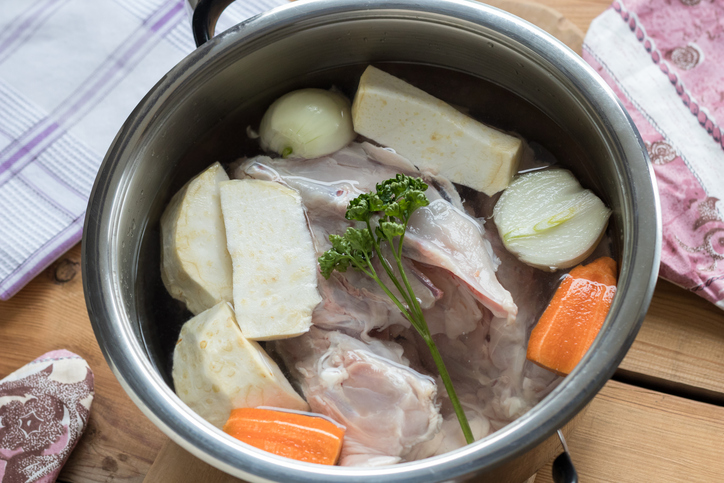
14. Use supplements to stay healthy
‘I recommend a good post-natal multi vitamin. There is varying debates out there about how much we absorb of the nutrients in a pill format, its definitely better to get it from natural food sources, but early motherhood is a stressful time so its worth taking a multi vitamin as well as a balanced diet to make sure your covering all bases.
‘I also recommend Pukka Herbs Tulsi Tea. Tulsi is an adaptogen which helps to balance out cortisol levels. When we are sleep deprived our cortisol levels tend to fluctuate and cortisol encourages the body to hold on to fat. Stress does not leave to a good environment for healing. It’s a nice flavour tea too, especially if you’re breastfeeding and you can’t have caffeine.
TRY: Healthista’s favourite supplements for pregnancy
15. Don’t jump back into classes
The worst thing I see mothers doing is planks
The biggest mistake is to go running or join the nearest bootcamp. These tend to be the women who have an ok birth and they think everything is ok. Our society does place this pressure on us to get back to normal life and our media is obsessed with this whole yummy mummy and ‘doesn’t she look amazing juggling everything and looking good’. The problem with group classes is that there is a slight competitiveness in that you feel under more pressure to carry on even if something is not feeling right. The worst thing I see mothers doing is planks. There is too much pressure ont heir core, but the person next to them is doing it so they feel they need to. Its pushing things too quickly and I tend to err on the side of caution for at least six months. There are so many exercises you can do that don’t put your core and pelvic floor under such pressure.
16. Chill out about excess weight
Of course you will put on maternal weight during pregnancy. I usually put on 20-25 kilos. But I’m chilled about that because that’s normally the placenta, extra blood, and yes there is maternal fat around my thighs and hips. But the key is to eat a well balanced diet during pregnancy (not eating for two!) and it won’t be so difficult to eat healthily after you’ve given birth. Then that maternal fat you put on will go on its own, you just have to have some faith and patience. Some will heal and lose quicker than others, but that’s just life!
17. Stop trying to be perfect
Shut your blinkers off and stop worrying about what everyone else is doing. Celebrate your body as it’s just done something amazing. Try not to be on Instagram the whole time or looking at the wrong accounts. Find positive accounts that are giving the right message. Binky is doing a great job of that. I think it’s really important to just spend time having you time whether you enjoy meditation, yoga or massage. There is so much pressure on us to be the perfect person – wife, mum, fun friend whilst holding a job down if you are, it can all get too much. There is a great book, The Supermum Myth by Anya Hayes. It was the most refreshing thing I’ve read in a long time. It made me realise it’s not just me that worries about being the perfect person. It gives useful tips on how to really manage those feelings.
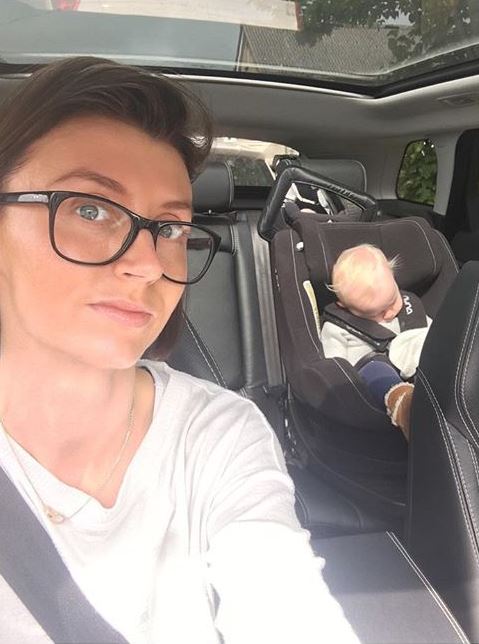
18. Be patient
I have a client 8 years post natal and we are still working on the core. It’s impossible to give general advice, but if everything is healing well according to a Women’s Health Physio and you’re sticking to a sensible low impact exercise plan, generally speaking you can build up the intensity after six months. It’s important to remember the ligaments in your body that stabilise the joints, particularly around the pelvis that support the pelvic floor muscles, loosen due to a hormone called relaxin during childbirth. The ligaments don’t get back to normal levels until two and a half years after childbirth. You need to be aware of that if you are aiming to be back at pre-pregnancy strength.
19. What to do when you pregnancies are close together
‘That’s what I’m going through now. Diastasis recti, when the core separates, normally happens in the second or third tremester of pregnancy. But when pregnancies are close together it happens a lot quicker. Look out for a doming of the tummy, which is when the midline tissue rises up into a cone-like shape down the length of your tummy.
‘It’s not a bad thing, you just need to be a lot more aware of what you are doing in order to avoid potentially causing bigger problems such as a bad back, pelvic floor dysfunction, hernia, or pelvic organ prolapse. I think this is especially the case for women with toddlers at home etc who will be doing heavy lifting throughout their pregnancy. Ways to avoid this are rolling onto your side and pushing yourself up when you get out of bed instead of sitting straight up. I protect my abs with physio tape, and you can use support belts, too. But I would recommend seeking the advice of a physio or chiropractor as taping too tight or wearing the wrong belt can actually worsen the problem.’
Postnatal exercises for the core
Lulu Adams shares exercises to do at home for postnatal core strengthening.
- The Purposeful Breath: how to use your breath to gently retrain and strengthen your deep core muscles.
INHALE (the expansion):
- Breathe into the sides of the ribs. Put your hands here to ensure the ribs are moving out, into your hands as you breathe in
- Allow your diaphragm to descend
- Relax the pelvic floor (think about allowing your sitting bones to separate and take the breath down through the pelvic floor)
- Make sure the abdominal wall relaxes. Don’t ‘push’ it out, but you will feel a passive movement of the abdominal wall as it relaxes out in front of you.
EXHALE (the compression):
- Activate the pelvic floor: imagine an elephant’s trunk with TWO nostrils (bear with me!) your pelvic floor is the base of the trunk and you want to think about picking up two raisins from the floor and drawing them up inside you.
- At the same time we want you to activate your deep abdominal muscles, so imagine you have a magnet on each hip bone that are drawing in towards one another.
- We also want your diaphragm to lift, so think about drawing your tummy button up towards your ribs. I often tell my clients to imagine they are ‘zipping up’ an internal corset!
- Contract the rib-cage down, and see if you can sense the muscles in your back contracting/tensing to support your core.
2. Pelvic tilts
- Lie on a mat with knees bent and feet flat on the floor.
- Take a relaxed breath in, allowing your tummy to gently relax outwards and imagining your sitting bones to moving apart from one another.
- Then as you breathe out – gently tilt your pelvis towards you (think of drawing your pubic bone closer to your ribs) so that you flatten your back into the mat beneath you, and keep it there for the full exhale.
- Repeat 6-8 times on each side.
- Activate your pelvic floor and deep abdominals as described above, and then gently flatten your lower back into the floor and return to your resting position.
3. Leg raises:
- Lie on a mat with knees bent and feet flat on the floor.
- Take a relaxed breath in, allowing your tummy to gently relax outwards and imagining your sitting bones to moving apart from one another.
- Then as you breathe out – without letting your back arch up off the mat – lift one bent leg up so you have a 90-degree angle at your hip.
- Return it to the floor before you need to inhale, and then repeat on the other side.
- Repeat 6-8 times on each side.
4. Head lift/mini crunch:
- Lie comfortably with your head on a pillow, knees bent and feet flat on the floor.
- Use the breathwork described above, and as you breathe out, gently lift your head and shoulders off the pillow.
- Keep an eye on your tummy and make sure there is no doming.
- Repeat 8-10 times.
5. Heel Slides:
- Lie on a mat with knees bent and feet flat on the floor.
- Take a relaxed breath in, allowing your tummy to gently relax outwards and imagining your sitting bones to moving apart from one another.
- Then as you breathe out – without letting your back arch up off the mat, slowly extend one heel out so the leg is straight (keep it hovering just off the floor) and draw it back in before you you need to inhale, and then repeat on the other side.
- Repeat 6-8 times on each side.
Lulu Adams is a personal trainer based in the Isle of Wight with qualifications as a Barre Concept Instructor, a Suspended Movement (TRX) Instructor, a Kettlebells Instructor, an Indoor Cycling Presenter, a Level 3 Personal Trainer and a Pre and Post Natal Fitness Specialist. In two weeks, she will be launching her new website, The Mummy Collective, which will have expert advice on nutrition, exercise, mental health and beauty both pre- and post- pregnancy. Find out more now at lulusfitness.com
Like this article? Sign up to our newsletter to get more articles like this delivered straight to your inbox.




